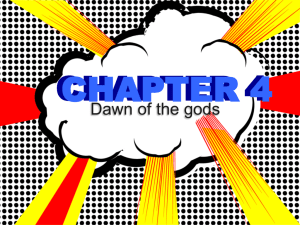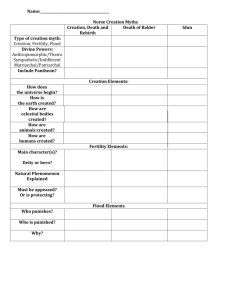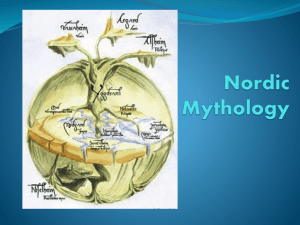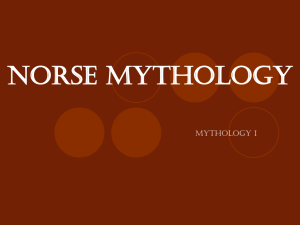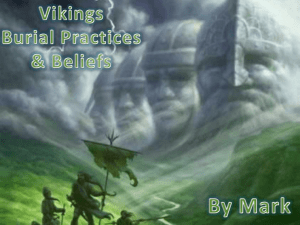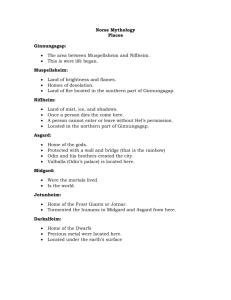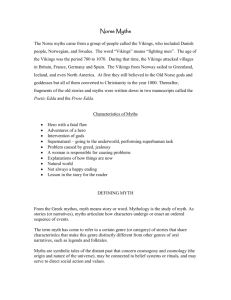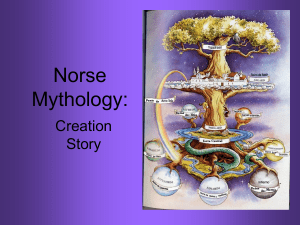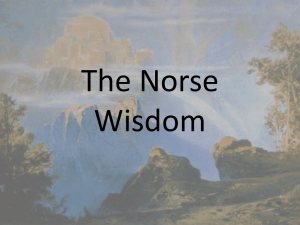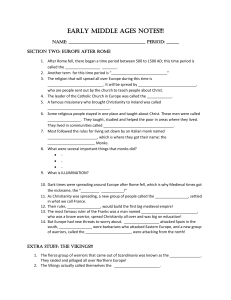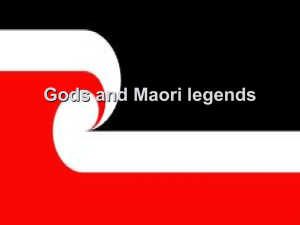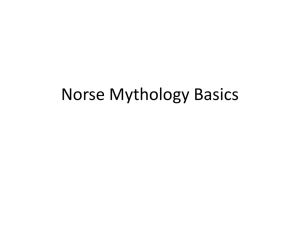Norse Religion and Mythology
advertisement
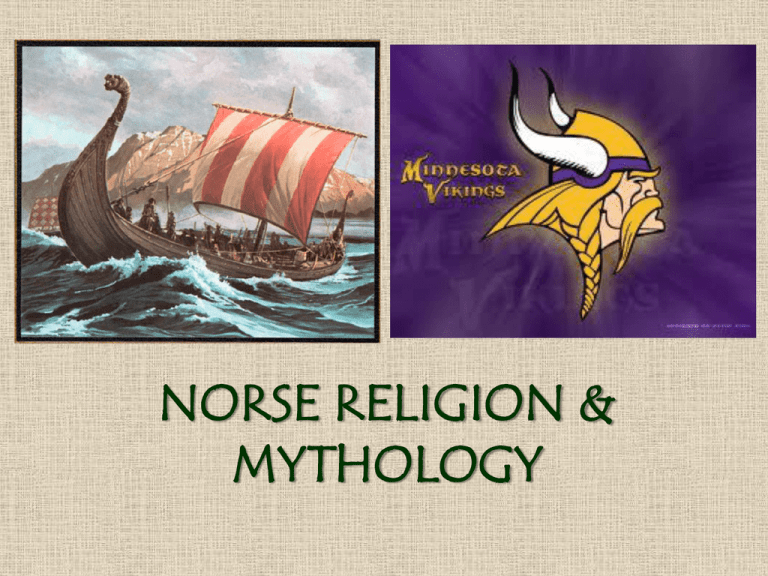
NORSE RELIGION & MYTHOLOGY Who are the Norse? • The Norse people were also called Vikings (meaning expedition) • The Vikings came from Norway, Sweden and Denmark. • Scandinavia was not fertile so the Vikings travelled and expanded their territory establishing settlements from Russia to Vinland (present day Newfoundland) The Vikings were the first Europeans to reach North America. The Vikings seemed to get everywhere... Eric the Red founded a new settlement in Greenland. The Vikings had settlements in Iceland in the ninth century. The French king gave the province of Normandy to a Viking duke named Rollo to stop him attacking. The Vikings settled in an area called Rus. The name Russia comes from this word. Sagas and Runes • Sagas • Viking children did not go to school so instead, lessons came in the form of Sagas or long stories. • Described the adventures of great Viking warriors or gods. • Used to teach history, geography and navigation. • The Vikings often decorated buildings with pictures from famous sagas. • Runes • The Viking alphabet was called the Futhark. • The letters or runes were carved into wood or stone. The runes are made of straight lines so it is easier to carve them. Norse Myth Sources Norse myths existed only in oral form while they were central to religious belief. They were only written down after Northern Europe had become Christian. So we have new problems with our primary sources: • no coherent body of literature showing the myths and legends • possible alteration due to the influence of Christianity • “fictionalization” of stories which originally had religious importance. Plus: • a wide time span, wide geographical range and many different sub-cultures Sources The Prose Edda. A narrative of many different adventures of the Norse gods. Poetic Eddas: Traditional songs, which often refer to mythic incidents, usually just individual adventures. Skaaldic Songs: poems in honor of human accomplishments, with occasional references to myth, sometimes very cryptic. Creation: Fusion of hot and cold In the south was a land of fire; in the north was a land of ice. They met in the great emptiness of Ginnungagap, and the ice began to melt. From the melting ice came a huge giant, Ymir. The first man and woman grew from under his arms. The frostgiants grew from his feet. Ymir fed on the milk of a cow, which licked another creature, and created a man named Bur, from the ice. Creation Bur’s grandsons, Odin and 2 others, killed Ymir and made the world from his parts: • his skull became the sky • his eyebrows formed a barrier between the world of men and the world of giants • his blood became sea and lakes • his bones became the mountains Norse mythology was extremely complex with nine different worlds. All nine worlds were connected by a tree. Asgard (realm of the gods) could only be reached by crossing the Rainbow Bridge. The Realms of Existence • Asgard – where the gods lived • Midgard – where humans lived • Hel – the underworld of the dead • Creation was all tied together by Yggdrasill, the world tree. The Gods The Norse gods are divided into two races: Aesir and Vanir. Aesir are dominant; they are the gods most associated with heroic tales, conflict with giants, warfare, and the beginning and end of the world. Vanir tend to be fertility deities; there are fewer of them. Odin, Thor, and Loki • The most important figures in Norse mythology were Odin and his sons Thor and Loki. – Odin is the chief of the gods. His wife is Frigg, whose name means fate. – Thor is a god of thunder, with the muscle, violence, and brute strength laced with intelligence, that we see in Heracles. – Loki is a trickster figure, often on the side of mischief or even evil; his father was a giant. Thor: ancient & modern ideas . . . Ragnarok – The “Twilight of the Gods” • The end of the world • Similar to Christian concepts • Good vs. Evil • But… Ragnarok – The “Twilight of the Gods” Norse myth, unlike Greek, does not portray a world in which the gods have conquered discord and established order, but a world in which the gods are constantly battling their adversaries. This battle comes to a head at Ragnarok. The death of Balder (god of light and beauty) is one element in the final episode of Norse myth, Ragnarok, “The Twilight of the Gods.” Ragnarok Loki remains suffering under the poison of the serpent, and Balder remains in Hel (rather than in Valholl!) until the conflicts of Ragnarok. The end of the world is preceded by an increase of wars and conflicts among men; then there is a three-year winter. Monsters break loose, Iormungand emerges from the sea and floods the earth. A wolf swallows the sun and her brother the moon; stars fall from the sky. An age of axes, an age of swords, shattered shields, an Age of tempests, an age of wolves, before the age of men crashes down. Led by the giant Surt, with Loki as the helmsman, the giants arrive in their ship, Naglfar, made from the uncut fingernails of the dead. A huge battle between gods and giants takes place at the gates of Asgard. Ragnarok • Thor is killed by the venom of a poisonous serpent. • Odin is eaten by Fenrir, a monstrous wolf. • But from this destruction comes a new world and those who remain hidden in Yggdrasill will repopulate the world. • Thus the end will contain the germ of a new beginning, and the cycle will start again. finis
